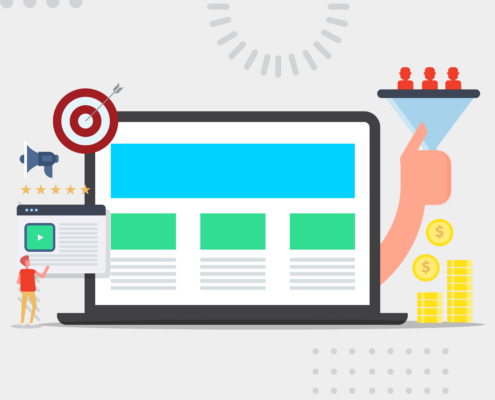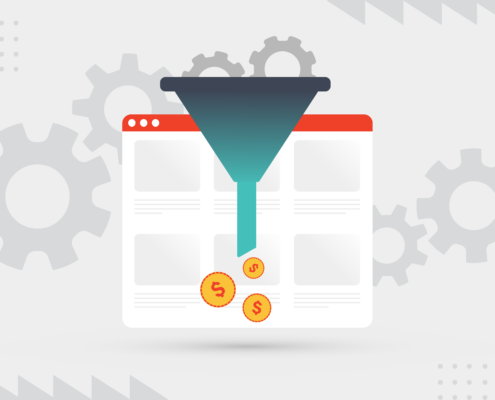

While the phrase B2B lead generation is thrown around a lot, there’s a lot of confusion about what it is. Before you implement a B2B lead generation strategy for your company, learn its basics and how it helps businesses grow.
In this blog, we’ll cover the following:
Definition of B2B Lead Generation
B2B lead generation, short for “business-to-business lead generation,” is the process of identifying, attracting, and converting potential business customers into qualified prospects who could benefit from your company’s offerings. B2B transactions occur between two or more businesses, pitching to decision-makers rather than consumers.
The main objective of B2B lead generation is to cultivate a sales pipeline of qualified leads that are likely to convert into paying customers. Companies often employ various sales and marketing strategies to generate these leads through outbound and inbound marketing efforts (which we’ll expand on later).
Once leads are collected, businesses typically nurture and engage with them through targeted communications and personalized interactions, aiming to guide them through the B2B sales funnel and ultimately convert them into customers. Effective B2B lead generation is crucial for sustainable business growth and maintaining a steady stream of prospective clients in the competitive B2B marketplace.
What Are B2B Leads?
B2B leads are potential business customers or prospects that have expressed interest in a product or service offered by one business to another.
B2B leads are typically generated through various sales and marketing efforts, such as lead generation campaigns, networking events, content marketing efforts, email marketing, and more. These efforts aim to attract and engage businesses that may have a need or interest in the products or services being offered.
B2B leads should be divided into sales qualified leads (SQLs) and marketing qualified leads (MQLs), so those involved with the business growth strategy know how to effectively score leads and move them throughout the sales funnel, increasing the likelihood of a conversion.
SQLs and MQLs: What’s the Difference?
Sales qualified leads (SQLs) are prospects that have been thoroughly vetted and deemed ready for direct sales engagement. SQLs have displayed strong intent to purchase, meet specific criteria, and are more likely to convert into customers. These leads have progressed further down the sales funnel through interactions with marketing materials and sales representatives, demonstrating a higher level of interest and qualification.
On the other hand, marketing qualified leads (MQLs) are prospects that have demonstrated an interest in a company’s offerings through various marketing efforts. They often engage with content, subscribe to newsletters, or attend webinars, indicating potential interest in the product or service. MQLs are typically at the top or middle of the sales funnel and require further nurturing and engagement from the marketing team to move them closer to a purchase decision.
Ready to fill your sales pipeline with more sales and marketing qualified leads? Contact us today to learn how we can be your partner in B2B lead generation!
Why Is B2B Lead Generation Important?
B2B lead generation is a critical component of growing businesses, and implementing it into their everyday business functions offers many significant advantages. Here are some key reasons why B2B lead generation is essential for business growth:
- Expand customer base: B2B lead generation helps businesses attract and engage with potential customers who are genuinely interested in their products or services. By nurturing these leads through the marketing funnel, companies can expand their customer base and increase their market reach.
- Increase sales and revenue: More leads mean more opportunities to convert them into paying customers. A consistent and effective B2B lead generation strategy can lead to a higher conversion rate and increased sales, directly impacting the revenue and profitability of the business.
- Long-term sustainability: Relying solely on existing customers for revenue can lead to stagnation or limited growth. B2B ead generation ensures a steady flow of fresh prospects, reducing the business’s dependence on a few clients and providing a more stable foundation for long-term success.
- Competitive advantage: In today’s competitive market, businesses need to stay ahead of their rivals. By actively generating leads and converting them into customers, a company can gain a competitive edge and position itself as a leader in its industry.
- Better targeting and personalization: B2B lead generation enables businesses to identify and focus on their ideal target audience. By understanding the specific needs and preferences of potential customers, companies can tailor their marketing efforts to provide more personalized solutions, increasing the chances of conversion.
- Improved marketing ROI: Implementing a well-designed B2B lead generation strategy allows businesses to allocate their marketing resources more efficiently. By targeting the right audience and investing in channels that yield better results, businesses can optimize their marketing return on investment (ROI).
- Customer relationship building: B2B lead generation doesn’t end with the conversion. It also involves ongoing engagement and relationship building with customers. By maintaining strong connections with clients, businesses can increase customer loyalty, encourage repeat purchases, and benefit from positive word-of-mouth referrals.
- Data-driven decision-making: B2B lead generation involves tracking and analyzing various metrics to understand what works best for the business. This data-driven approach empowers companies to make informed decisions and continually improve their lead generation efforts.
- Innovation and adaptation: As businesses generate leads and interact with potential customers, they gain valuable insights into market demands and preferences. These insights can drive innovation and help companies adapt their products or services to meet evolving customer needs.
B2B lead generation is crucial for growing businesses as it provides a systematic and proactive approach to attracting and converting potential customers. By implementing lead generation into their everyday business functions, companies can fuel growth, remain competitive, and build strong relationships with their customers, ensuring long-term success.
Who Is Responsible for B2B Lead Generation?
B2B lead generation is a collaborative effort that involves multiple departments within an organization working together to attract and convert potential customers into leads. The main departments responsible for lead generation include sales, marketing, and sales development.
Sales
Sales departments contribute to B2B lead generation by actively engaging with potential customers, identifying prospects during sales interactions, and nurturing relationships.
Through networking, referrals, and outreach, sales or account executives can uncover new business opportunities and generate leads. By understanding the pain points and needs of potential clients, sales teams can tailor their messaging and provide valuable insights, positioning the company as a solution provider.
Additionally, follow-up communications and personalized interactions with leads can help move them through the sales funnel, ultimately converting them into qualified opportunities and contributing to the growth of the customer base.
Marketing
Marketing departments are instrumental in B2B lead generation through various strategic initiatives.
They create and implement targeted marketing campaigns, such as content marketing, email marketing, social media marketing, and search engine optimization, to attract potential customers and capture their interest. By producing valuable content and engaging with the target audience, marketing teams generate leads and encourage them to provide contact information.
Through lead nurturing, the marketing department further guides these leads through the sales funnel, qualifying them and preparing them for sales engagement. By leveraging data analytics and continuous optimization, marketing departments play a pivotal role in growing the company’s customer base and driving business growth.
Sales Development
Sales and marketing teams have a lot on their plate. When they can no longer keep up with their daily sales and marketing tasks, companies often looking into extending their business growth teams by hiring sales development experts to act as liaisons between the two departments.
While this department is relatively new compared to sales and marketing, they play a key role in B2B lead generation by proactively identifying and qualifying potential customers, allowing sales and marketing teams to spend more time making sales pitches and creating high-quality content.
Sales development teams conduct targeted prospecting and outreach efforts, engaging with potential clients through phone calls, cold emails, and social selling. By initiating conversations, gathering valuable information, and gauging interest, sales development teams can determine the viability of leads.
They nurture these prospects, guiding them through the initial stages of the sales funnel and passing qualified leads to the sales team for further engagement. Through their persistent efforts and lead qualification expertise, sales development teams contribute significantly to expanding the customer base and driving revenue growth.
Best Ways to Perform B2B Lead Generation
The best ways to perform B2B lead generation can vary depending on the nature of the business and the target audience. However, some effective strategies include outbound and inbound lead generation, which embodies various sales and marketing techniques.
Outbound Lead Generation
Companies can perform B2B sales lead generation through outbound marketing and B2B appointment setting efforts by proactively reaching out to potential clients and securing sales meetings with decision-makers. Here’s a step-by-step explanation of the process:
- Define Target Audience: Begin by identifying the ideal customer profile and target industries that align with the company’s offerings.
- Build Prospecting Lists: Create well-researched and segmented lists of potential leads based on demographics, company size, industry, and other relevant criteria.
- Outbound Lead Generation: Use various outbound methods such as cold calling, cold emailing, and social selling to initiate contact with potential leads. Personalize the outreach to address their pain points and demonstrate how the company’s products or services can provide solutions.
- Qualify Leads: During the outreach, engage in conversations to qualify leads based on their level of interest, budget, authority, and timeline for purchase decisions.
- B2B Appointment Setting: For qualified leads, focus on scheduling appointments with key decision-makers or stakeholders. Ensure that the appointments are relevant, valuable, and aligned with the prospect’s needs.
- Follow-Up and Nurturing: Continuously follow up with leads through personalized communication channels. Share valuable content, insights, and case studies to nurture leads and keep the company top-of-mind.
- Lead Management: Maintain a well-organized lead management or customer relationship management (CRM) system to track and manage lead interactions and appointment schedules effectively.
- Adapt and Optimize: Continuously analyze the results of outbound efforts, identify areas of improvement, and optimize the lead generation process accordingly.
- Collaborate Between Sales and Marketing Departments: Ensure seamless collaboration between sales and marketing teams to align messaging, strategy, and goals for more effective lead generation.
By employing outbound lead generation and B2B appointment setting strategies, companies can proactively engage with potential clients, build relationships, and increase the chances of converting qualified leads into loyal customers. The approach requires persistence, personalized outreach, and a keen understanding of the target audience’s needs and pain points. When executed effectively, these efforts can significantly contribute to the company’s growth and success in the B2B market.
Inbound Lead Generation (B2B Digital Marketing)
Companies can perform B2B lead generation through inbound lead generation and B2B digital marketing efforts by attracting potential customers to their brand through valuable content, online presence, and engagement. Here are some ways that lead generation teams can generate inbound leads for this sales pipelines:
- Content Marketing: Develop a robust content marketing strategy that focuses on creating high-quality and relevant content such as blog posts, e-books, webinars, videos, and case studies. This content should address the pain points and challenges faced by the target audience.
- Search Engine Optimization (SEO): Optimize the website and content for relevant keywords to improve search engine rankings and organic visibility. This helps potential clients find the company when searching for solutions related to their needs.
- Social Media Presence: Establish a strong presence on relevant social media platforms where the target audience is active. Share valuable content, engage with followers, and participate in industry discussions to build brand awareness and credibility.
- Email Marketing Campaigns: Develop targeted email campaigns that provide value to the recipients. Offer content upgrades, newsletters, and industry insights to encourage lead generation and nurture prospects.
- Lead Magnets and Landing Pages: Create lead magnets, such as downloadable resources or free trials, and design compelling landing pages that capture visitors’ contact information in exchange for access.
- Webinars and Virtual Events: Host webinars and virtual events on relevant topics to showcase expertise and attract potential clients. Gather contact information from webinar registrations and follow up with attendees.
By leveraging inbound lead generation and B2B digital marketing efforts, companies can position themselves as industry thought leaders, attract potential clients, and generate high-quality leads that are more likely to convert into loyal customers. This approach focuses on providing value to the target audience, building trust, and nurturing relationships, creating a solid foundation for long-term business growth.
What Role Does Technology Play in B2B Lead Generation?
Technology plays a crucial role in B2B lead generation, revolutionizing how businesses identify, engage, and convert potential customers. Here are some key ways technology impacts lead generation:
- Data and Analytics: Advanced data analytics tools allow companies to gather valuable insights into their target audience’s behavior, preferences, and pain points. By analyzing data from various sources, businesses can create more targeted and personalized lead generation strategies, optimizing their efforts for better results.
- Marketing Automation: Technology enables marketing automation platforms that streamline lead nurturing processes. Automated email sequences, personalized content delivery, and lead scoring help businesses nurture leads at scale, ensuring timely and relevant interactions to move prospects through the sales funnel.
- Customer Relationship Management (CRM) Systems: CRM systems centralize lead data, track interactions, and provide valuable information to sales and marketing teams. These platforms help manage and organize leads, facilitating efficient lead nurturing and better collaboration between teams.
- Social Media and Content Distribution: Technology facilitates the distribution of content and promotional materials across various social media channels. This widespread reach enables businesses to engage with a broader audience, attract potential leads, and drive traffic to their websites or landing pages.
- Website Optimization: Technology allows businesses to optimize their websites for lead generation. User-friendly interfaces, responsive design, and strategically placed call-to-action buttons help capture leads’ attention and encourage them to take action.
- AI and Chatbots: Artificial Intelligence (AI) and chatbots offer instant and personalized responses to website visitors’ inquiries, enhancing customer experiences and capturing leads even outside business hours.
- Account-Based Marketing (ABM): Technology enables the implementation of account-based marketing strategies, targeting specific high-value accounts with personalized campaigns to generate qualified leads.
- Lead Scoring and Segmentation: Technology facilitates lead scoring and segmentation based on factors like behavior, engagement, and demographic data. This helps prioritize leads for focused follow-ups and ensures resources are directed to the most promising prospects.
Technology empowers businesses with valuable tools and insights to streamline B2B lead generation processes, automate repetitive tasks, and improve the overall efficiency and effectiveness of lead generation efforts. By leveraging these technological advancements, companies can gain a competitive edge, achieve higher lead conversion rates, and sustainably grow their customer base.
Key Takeaways
B2B lead generation plays a core role in a business’s growth. With a consistent and effective strategy in place, your business growth experts have the opportunity to engage more prospects and generate a more consistent stream of revenue.
For effective B2B lead generation, you need a whole team of sales and marketing experts to tackle all of the moving parts. You may not have the time, money, resources, or internal B2B lead generation team, but there are capable third-party sales and marketing companies that can help you grow your business.
At Abstrakt Marketing Group, our team is trained to deliver qualified sales appointments and high-converting marketing collateral for our clients. If you need a boost with your company’s lead generation efforts, contact the sales reps at Abstrakt Marketing Group!




